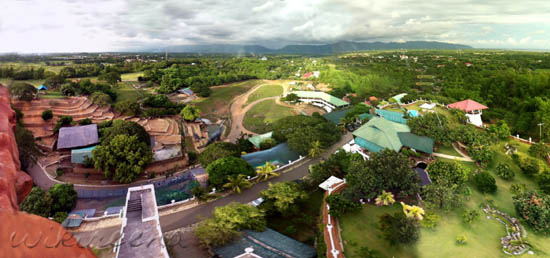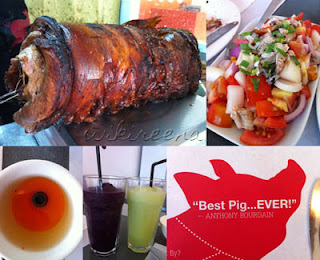The name Pundaquit (poon-da-kit) I think is very fitting for the place, mainly because it is really nakaka-akit or charming. See, "akit" is synonymous to charm, or to fascinate, captivate and other similar words you can think of. I hope you can see for yourself why I can say that the place is such. With this place so near, who can resist?
 |
| The view as you approach Nagsasa Cove. Simply breathtaking! |
HOW WE GOT
THERE
Zambales,
specifically Olongapo city, is about 3 hours away from Manila. Pundaquit is a seemingly quiet and sleepy baranggay in
the town of San Antonio, a fishing town about 30 minutes to an hour's drive away
from Olongapo.
We took a
car to get there, via the North Luzon Expressway (NLEX), taking the San
Fernando exit towards the Subic-Clark-Tarlac Expressway (SCTEX) towards SBMA to
Olongapo.
My dad knew
his way to Olongapo and my sister’s boyfriend knew his way around so we didn’t
have much of a difficulty finding our way to San Antonio. However, if it’s your
first time, best to ask around for directions to Olongapo and San Antonio.
Locals are generally helpful; or better yet, hire a tricycle driver to take you
to your resort of choice.
You can
also take the public bus. Victory Liner has trips to Sta. Cruz and Iba,
Zambales, which you can take. Just make sure to tell the bus conductor you will
get down at San Antonio town proper (think City Hall, Public Market, etc.). You
can hire a tricycle to take you to your resort for as low as PhP 50 to as much
as PhP 150, depending on the number of passengers and where your resort is.
WHAT TO DO
THERE
Surf or
body/boogie board! The town of San Antonio is very well known as a surf spot
or jump-off point to other surf spots in the vicinity. You can ask around for
board rentals or lessons form locals. This activity of course is dependent on the weather conditions. Best to go during the rainy season, possibly between months of July 'til November.
Go Camping. With Nagsasa Cove and Anawangin Cove just a boat ride away, who can resist
the charm and adventure of camping? There are local guides who can assist and
join you for a minimal fee. Make sure to agree on the rate and terms for the
guide and the boat that will be bringing you to and from the camp spot before
departing. Should you decide to just have a boatman bring you to the camp
sites, make sure you agree on a pick-up time and get the boatman’s number for
any emergency. Do not forget to bring enough food and water, plus do the earth a favor - bring back with you whatever it is that you bring to you when you go camping. Do not leave trash behind.
 |
| Seeing Capones and Camara Islands from Pundaquit |
Island-hop
to Camara and Capones Islands. These can be seen from the shorelines of
Pundaquit and can be reached by boat. You can spend the day there or even camp
if you’re brave enough to risk the tide and winds. You can ask your resort or
hotel for boat rentals they trust and can endorse just to be sure.
Trek to the
waterfalls or coves. If you’re into trekking or climbing, then this is the
activity for you. You can trek to the Pundaquit Falls or to Anawangin Cove.
Just make sure to have a local guide with you should anything unexpected
happens.
 |
| Anawangin Cove |
WHAT TO
SEE
Anawangin Cove is possibly the most popular of the attractions in San Antonio. With the sea,
the white sand, the pine tree-lined shore, and the beautiful mountain range as
backdrop, who wouldn’t find this place beautiful? You can trek going there or
take a boat ride, which will take about 30 minutes to an hour, depending on the
water and weather condition. When we went, we found out that the area is already privately owned. However, it's still open for visitors for a minimal fee for the day. There are still camping areas for those who wish to stay overnight and some upgraded facilities
for those who may not be able to do potty training in the woods.
 |
| Where freshwater meets saltwater at Nagsasa Cove |
Nagsasa Cove is
more secluded compared to Anawangin as it is farther. It will take you about 45
minutes to 1 hour to get there. The sand is light gray, unlike Anawangin, but
the charm of the cove lies in its being secluded. The views are simply
breathtaking. In this area is also the point where fresh water (of the
mountains) meets saltwater (of the ocean) so the water temperature can get
quite interesting in some parts. You can stay here and camp out for a minimal
fee. They also have put up toilets for those who are not so comfortable going
all out in the camping experience.
The
Lighthouse at Capones Island was built in the 1800s and serves as a guide for
vessels headed towards Subic Bay (or to farther Corregidor and Manila Bay).
Another rather interesting sight.
 |
| The Coffee Shop's Jumbo Taco |
WHERE TO
STAY and EAT
We were
only in Pundaquit for two whole days, mostly lounging around in front of our
cottage and in Nagsasa, taking in the serenity and the view. Thus, we didn’t
get to explore much. We stayed at Sam’s Resort (0919-7033597), a small
family-run business. They have about 10 rooms, with 3 to 4 of those in native
cottages. Ate Arlene and the rest of the family were very accommodating, and
cooked for us at a very reasonable price. With San Antonio being a fishing
town, make sure you sample the fresh seafood from the area.
 |
| Capones Vista Resort's rooms facing the pool |
You can also opt to
stay at Capones Vista Resort or Punta de Uian, more upscale options compared to the smaller
resorts in the area.
Make sure
to drop by The Coffee Shop at Barrio Barretto in Olongapo City. It’s actually a
restaurant and hotel, but they’re known for their mean tacos. One order can be
good enough for two, but considering the trip, an order can feed a hungry soul.
 |
| C' Italian Dining: Home of the Panizza |
On our way
home, we also stopped at C’ Italian Dining over at the Perimeter Road in
Angeles City (near the Friendship Highway). We’ve heard and read so many good
things about it and they were saying it’s where the panizza originated. Heck,
even Bonnie Bailey ate there. So we felt we had to try it for ourselves. The
ambience was very warm and intriguing that you’ll want to look around. We
ordered several kinds of soup and 2 kinds of panizza. We liked the overall
experience of the ambience plus the food, though I wouldn’t exactly say we’d
yearn to going back.
We weren't able to see Pundaquit Falls, Sinlanguin and Talisayin Coves. Soon, we hope to be able to go back and experience these places.
 |
| This 5-year old boy, only standing about three and a half feet in height amazed us as he ripped waves that afternoon. |


























